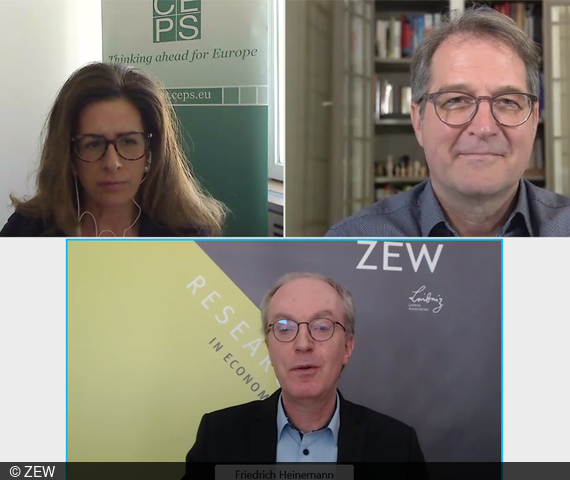“Next Generation EU Must Be a Success for the Eurozone to Escape the Next Debt Crisis”
ZEW SeminarThe COVID-19 crisis resulted in all European countries having to take on large amounts of new debt to mitigate the impact of the pandemic on the health system and the economy and to support recovery from the deep recession. As many countries had already been heavily indebted before, their scope to shoulder the high pandemic-related debt on their own was limited. Europe responded with comprehensive aid measures. At the end of 2020, the EU not only adopted the new Multiannual Financial Framework, but also launched the largest aid programme financed from the EU budget in its history, the 750-billion-euro fund Next Generation EU. But one central question remains: How should the high national debt in the eurozone be dealt with after the end of the coronavirus pandemic? What are the possible solutions and how realistic are they?
On 28 April 2021, Dr. Cinzia Alcidi, Director of Research, Head of the Economic Policy Unit at the Centre for European Policy Studies (CEPS) in Brussels; Professor Volker Wieland, professor of monetary economics at Goethe University Frankfurt and member of the German Council of Economic Experts; and Professor Friedrich Heinemann, research department head and public finance expert at ZEW, discussed this in a digital panel discussion at a research seminar organised by EconPol and ZEW in cooperation with the Brigitte Strube Stiftung.
In short keynote speeches at the beginning of the panel discussion, the participants presented their respective views. Friedrich Heinemann started by talking about the impact of communiqués by the EU and its key players on the interest rate spreads of euro member states. According to Heinemann, ZEW studies on the benefits of the ECB’s Pandemic Emergency Purchase Programme (PEPP) show that “PEPP was a game changer, whereas the EU’s pandemic recovery packages, for example, did not make a noticeable contribution to narrowing interest rate spreads. The stability of the euro government bond markets in the pandemic so far is therefore mainly attributable to the ECB’s PEPP programme.”
In his presentation, the ZEW expert reflected on six possible solution scenarios for government debt after the pandemic: One possibility is that there is no problem at all due to interest rates simply being low or because the ECB will ensure in the long run that interest rate spreads remain within an acceptable range even for highly indebted countries. Another possibility is further debt-financed EU transfers such as Next Generation EU. Fourth, the aid programme could spark overdue reforms that could lead to economic growth and thus reduce debt. Also conceivable is an effective consolidation of government budgets, especially through savings in government consumption. Finally, debt restructuring is also possible, as has taken place in the case of Greek public debt. “The situation becomes risky for EU countries where high debt levels are combined with a persistent reform backlog. The Next Generation EU recovery fund must necessarily be a success and finally put countries like Italy on a growth path. Only then can the eurozone escape the next debt crisis,” Heinemann made clear.
Economic growth is of utmost importance for indebted states
In another keynote speech, Cinzia Alcidi explored the question of how far the analysis of a country’s debt sustainability can be helpful in dealing with high government debt. Alcidi first presented various methods for measuring debt sustainability. She then outlined the sharp increase in public debt since 2009/2010, which lies considerably above the usual level in a recession. She went on to look at the likely further development of the deficit situation in the euro states, which she expects to remain at an average of over three per cent in the eurozone in 2022. At present, she noted, the markets are satisfied with this development. However, there are limits. For some countries, the situation could change very quickly, because the current historically low interest rate is not set in stone. The question is how long it will remain on such a low level. In Alcidi’s view, a return to significant economic growth is therefore of utmost importance for highly indebted countries in order to reduce the debt burden.
From her point of view, debt sustainability is difficult to measure scientifically in the current situation. “Nevertheless, it is of great importance as an early warning system, both for individual highly indebted countries, and for the eurozone, in order to ultimately be able to decide when substantial financial assistance is needed for countries in distress. However, this ultimately remains a decision that must be made by policymakers,” said Alcidi.
COVID-19 as a booster for national debt
The Council of Economic Experts member, Volker Wieland, sees the COVID-19 pandemic as a booster for government debt in the euro area. In Italy, Spain and France, the national debt has risen by ten to 20 per cent in relation to the gross domestic product. At the same time, interest rates have fallen, which means that it has become much cheaper for countries to take on more debt. However, Wieland warns of the associated risks and refers to the projections of the US Congressional Budget Office. With regard to US debt, the Office expects a noticeable increase in expenditure for interest payments from around 2026/2027 onwards. The projection shows that low interest rates will by no means remain a permanent condition in Europe either. But what can the euro states do against growing debt? For Wieland, a possible solution would be to adopt a spending-based consolidation strategy with the aim of growing out of debt by ensuring that government spending increases more slowly than economic activity. “An increase in taxes on labour and capital income should also be avoided,” said the economist and warned: “The ECB cannot assume a permanent function as a crisis helper, otherwise the boundaries between fiscal and monetary policy will become increasingly blurred.” According to Wieland, as soon as the economy recovers and inflation rises, the ECB must adopt a strategy to exit negative interest rates. The EU and its Member States should then reactivate their fiscal rules and aim for consolidation together with structural reforms to improve productivity and competitiveness.
Following the presentations, the panel discussed what room for manoeuvre remains for the euro states despite high debt levels. It became clear that the ECB cannot ensure low interest rates in the long run and that it is crucial for economic recovery to stimulate the private sector. Providing the right incentives, such as government support for future projects, e.g. for digitalisation and climate protection, could help to achieve this.

